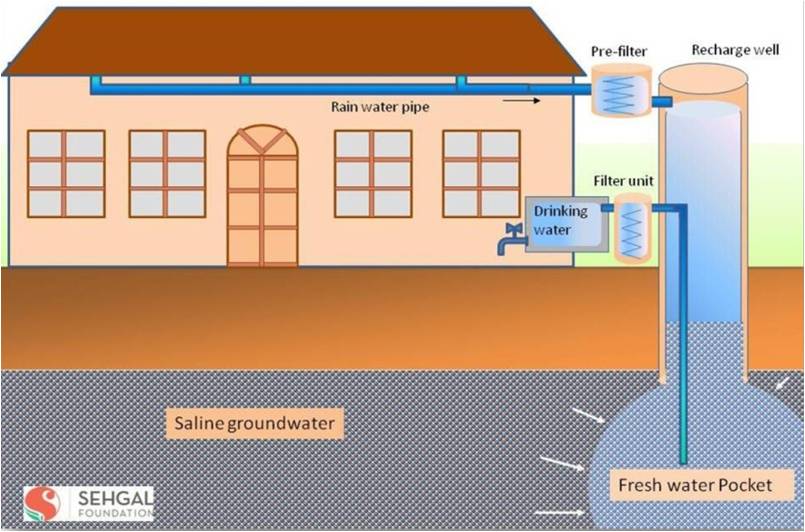Difference between revisions of "Create content"
| Line 1: | Line 1: | ||
| − | + | '''''Harvesting rainwater through an innovative model provides potable drinking water in Mewat''''' | |
[[Image:Schematic diagram of sweet water pocket within a saline aquifer.jpg | thumb | right | 150px | Click the picture to see the full size]] | [[Image:Schematic diagram of sweet water pocket within a saline aquifer.jpg | thumb | right | 150px | Click the picture to see the full size]] | ||
Latest revision as of 05:42, 15 December 2015
Harvesting rainwater through an innovative model provides potable drinking water in Mewat
The students and teachers of Government Middle School in Sukhpuri village of Mewat district, Haryana, are a happy lot today. The 356 students, who are thirsty during school hours, now have access to potable water, harvested from rain, right within their school compound.
The groundwater is saline in Sukhpuri, a tiny village in Nagina Block tucked in the Aravalli hills. The level of total dissolved solids (TDS) in the groundwater is 7,560 parts per million (ppm) , making the water unfit for consumption. Schoolchildren of Sukhpuri had always suffered the most from the scarcity of potable water. The school depended on tankers to meet water needs for drinking and cooking, at a cost of up to Rs.1,200 per month. Even though the quality of the tanker water was always questionable, there was no other alternative. For many years before, whenever tanker water was unavailable, the school had borrowed water from neighbouring households or, in extreme cases, children had to leave school and return home to drink water.
To tackle the water problem in Sukhpuri Government Middle School, Sehgal Foundation , a public charitable trust, registered in India since 1999 in Gurgaon, developed and constructed an innovative rainwater harvesting structure called a ‘high pressure recharge well’ (HPRW).
This well stores “sweet” rainwater below the ground, as a freshwater pocket within a saline aquifer (groundwater zone). This is achieved by recharging collected rooftop rainwater, below the water table, with gravity-induced hydrostatic pressure. For this, the recharge well is sunk to a depth, lower than the existing groundwater level and raised to an above ground height to gain additional hydrostatic pressure. As rainwater enters this well, hydrostatic pressure pushes the existing saline water aside and forms a pocket of freshwater within the saline aquifer. Later, this sweet water is extracted with a hand pump. The water passes through a biosand filter that removes physical, suspended, and biological contaminants and is accessed through water taps at the school. The model is environment-friendly as the system requires no use of chemicals or energy.
The Sehgal Foundation field staff provides information about the benefits of HPRW to the community during their regular interactions and awareness-building activities. The team conducts a technical feasibility assessment for the school and seeks an approval letter from the school authority to commence the construction work. Financial contributions toward the project are collected and deposited in a bank to ensure the sustainability of the structure over a period of time. This instils a sense of ownership among the school authority and the Village Development Committee. While construction of HPRW is underway, the field team conducts water literacy sessions with community members and schoolchildren. Once the structure is functional, it is handed over to the school authority. Responsibility for the structure’s operations and maintenance lies with them. This includes cleaning the roof, maintaining the biosand filter, and replacing the taps and other parts of the structure in case of any damage.
This innovative model was originally conceptualised by civil engineer Lalit Mohan Sharma, who has been finding solutions to the water issues of rural Mewat for past 15 years with input from a talented team of experts. The primary issues in all the villages of Mewat were related to availability, accessibility, and quality of water. The HPRW was designed to address the prevailing conditions in the district, i.e., shallow groundwater table (depth about 4 meters), silt or sandy soil, and high levels of salinity in groundwater in all but 60 of the 431 villages of Mewat.
In November 2014, Millennium Alliance awarded a grant to Sehgal Foundation, to build the innovative model in four schools in Mewat and Sukhpuri is one of the schools. Sukhpuri has 356 school children and teachers and roof area of 3,024 s

